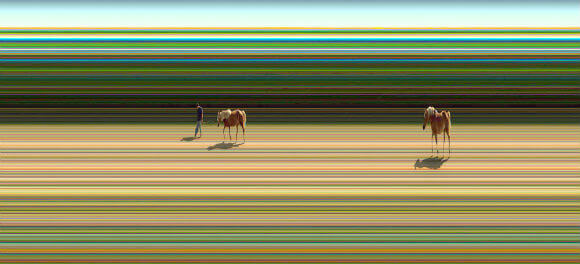Camera Technique Captures New View Of Space And Time

Share
What if you could compress a video clip into a single image? That's what Jay Mark Johnson, an artist and visual effects director, has accomplished through the use of a special camera technique. He calls the images "photographic timelines," and his collected works offer quite a shift to conventional perception.
Pictures ordinarily taken with a regular still camera make the exposure time short but the field of view large. For his images, Johnson does the opposite: a narrow field of view is captured over a large period of time. To do this, he uses a technique involving an $85,000 slit camera designed to produce panoramas, in which a motor turns the camera as it takes high precision vertical images and stitches the images together. A modified technique involved blocking the rotation of the motor, which allowed the resulting slices to be strung together in progression. A single composite image then is a sliver of space captured over an extended period of time.
In the image, anything that is stationary is repeated throughout the sequence (that's the horizontal lines across the image), but objects that move are only in part of the scene. Furthermore, the faster they move, the thinner they appear. In this way, a single image is capturing objects and their rate of motion through a sliver of space. The leftmost edge of the image is the furthest back in time.
"The effect is like stepping 'through the looking glass' with Alice," wrote Johnson in a statement describing his work in that what is stationary appears across the image, as a blur would look in a traditional photo, and what is in motion is clear.
Surprisingly, Johnson has been using the technique since 2005, refining his method and capturing more complex scenes since then. In his earliest attempts, images were unrecognizable, but through experimentation he was able to resolve objects and visually divorce them from the background. Further describing the images, he stated, "Because they seamlessly blend visual depictions of space and time into a single hybrid image they provide an altered 'spacetime' view of the world."
Be Part of the Future
Sign up to receive top stories about groundbreaking technologies and visionary thinkers from SingularityHub.


Along the way Johnson has worked on the visual effects of music videos, television series, and numerous films, including The Matrix.
Visually interpreting the images is reminiscent of trying to see objects embedded within a Magic Eye computer-generated image, which in their hayday pushed the boundaries of visual perception. Others have also ventured away from the conventional uses of cameras, such as the Descriptive Camera that produces written summaries of what is in the field of view. At the same time, improvements in camera technology and digital processing are opening up a whole new way of viewing the world through the use of high speed photography to capture water balloons bursting, tilt-shift photography that transforms real scenes into miniatures-scale models, and high dynamic range imaging that reflects more of the highlight and shadow details that the human eye captures.
Johnson's work serves to challenge notions of space, time, and human perception of both. While the work is shown in exhibits, it would be a brilliant way to teach physics or philosophy as it is a beautiful mashup of art, science, and technology. It's definitely worth taking some time to explore the full set of his collected works at his website.
To learn more about the camera technique and thoughts on what the images say about human perception, check out this panel discussion video from 2010 in which Johnson gives more background and insight:
David started writing for Singularity Hub in 2011 and served as editor-in-chief of the site from 2014 to 2017 and SU vice president of faculty, content, and curriculum from 2017 to 2019. His interests cover digital education, publishing, and media, but he'll always be a chemist at heart.
Related Articles

Your ChatGPT Habit Could Depend on Nuclear Power

Time Doesn’t Really Flow—Your Brain Just Makes You Think It Does

AI Can Now Design Proteins and DNA. Scientists Warn We Need Biosecurity Rules Before It’s Too Late.
What we’re reading






